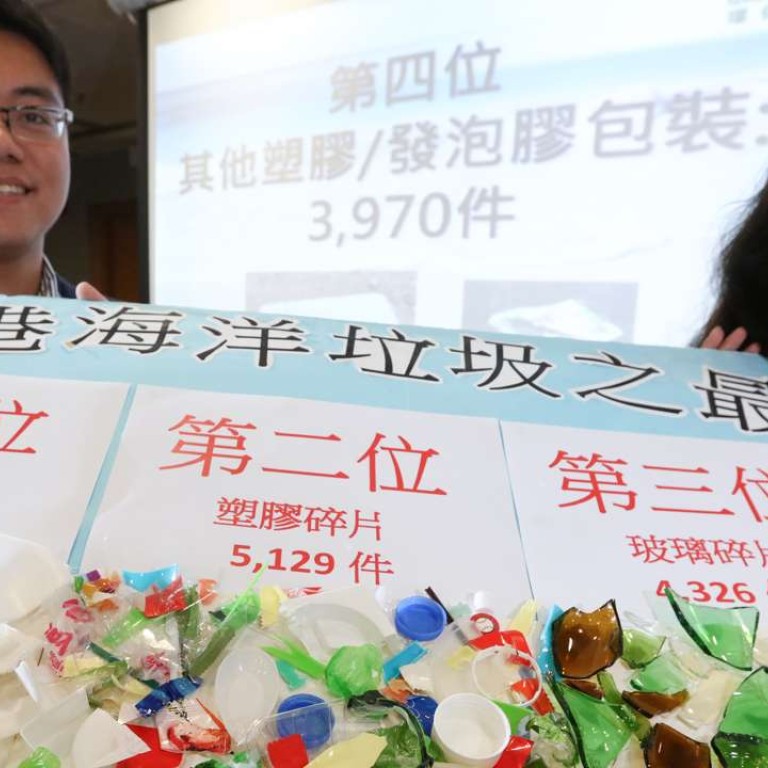
Rubbish found in clean-ups on Hong Kong beaches down by more than a third in 8 years, green group says
Amount this year 37 per cent less than that collected in 2008
The amount of foam boxes, plastic bottles and glass shards collected along Hong Kong’s beaches has dropped by more than a third in the past eight years, according to a green group.
Some 2,600 volunteers removed 54,605 pieces of rubbish, or 4,800kg, between September and November along the city’s coastlines during environmental group Green Council’s annual clean-up.
The amount was 37 per cent less than the 86,034 pieces collected in 2008 when the group hosted its first clean-up, and also the lowest ever on record.
The group has mobilised around 2,500 volunteers every year to clean up at some 30 sites across the city.
Kelvin Chiu Chun-kit, the group’s senior project officer, said it was partly due to the growing awareness among Hongkongers of the need to clean up after themselves.
Watch: Japanese travellers help to keep Hong Kong beaches beautiful
“Since the plastic pellets spill in 2012, people [check] to see if they have left any rubbish behind after they visit beaches or barbecue sites,” Chiu said.
In July 2012, six containers loaded with 150 tonnes of plastic pellets fell overboard and washed up on Hong Kong beaches after Severe Typhoon Vicente hit the city.
“Of course we hope to pick up less rubbish every year, but despite the good news, we still see that there hasn’t been any improvement in the consumption habits of using disposable products, which is the bigger problem here,” he added.

Seven out of the top 10 marine waste items collected were disposable, such as foam boxes, plastic bags, straws and plastic bottles, the group’s data showed.
In July, images of beaches littered with a deluge of rubbish went viral on social media. The waste had reportedly flushed out to sea due to unusually heavy rain and flooding in the Pearl River Delta.
Chief Executive Leung Chun-ying personally took part in a beach clean-up and said he would ask Guangdong authorities to follow up on the issue.
The Environmental Protection Department (EPD) reported a “six to tenfold” increase in rubbish at certain beaches during three weeks in late June and early July, compared with the same period last year.
The amount of shoreline and floating refuse collected by government departments in 2015 was 15,510 tonnes, while this year up to October it was 14,245 tonnes, according to the latest data from the EPD released on Wednesday.
There does not appear to be a consistent trend in the amount of marine refuse as fluctuating weather conditions have a “marked effect” on its accumulation, the EPD said.
The group, however, said at least 80 per cent of the marine waste was from Hong Kong and only a small portion showed indications it was from the mainland.
A study conducted by the EPD last April found 80 per cent of marine refuse was from land-based resources, meaning it was not dumped at sea, and was mainly the result of recreational activities such as barbecues and beach activities along shorelines.
The Green Council pointed out that despite the fall in overall figures, the amount of food wrappers and packaging saw a 77 per cent increase compared with last year.
Linda Ho Wai-ping, the group’s chief executive officer, attributed the rise to the implementation of a plastic bag levylast year.
“In order to make it convenient for customers, we’ve noticed that retailers have started to over package their products, which completely defeats the purpose of the levy, which hopes people would use less plastic,” Ho said.
The levy requires all retailers to charge customers no less than 50 cents for a plastic bag, unless the bags are to be used for holding food for hygiene reasons, packaging or non-retail purposes such as medical or dry cleaning services.
Top 10 marine debris items
1. Foam pieces
2. Plastic pieces
3. Glass pieces
4. Other plastic/foam packaging
5. Plastic beverage bottles
6. Bottle caps
7. Food wrappers
8. Other plastic bags
9. Cigarette butts
10. Straws/stirrers

